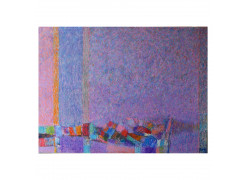Additional info:
Stelio Scamanga is an artist who stands at the intersection of multiple visual art and cultural conceptions: a multifaceted identity that has always made him sensitive to the Eastern vision of abstraction, all the while being nourished by the Greek foundations of Western culture. From 1964 onwards, he made a name for himself on the Beirut scene by showcasing his abstract arabesque motifs, and it was during this period that he published a major text: his manifesto, Toward a New Space: The Perspective of the Abstract. In it, he explains the fundamental differences in vision between the Renaissance perspective of the West, which he describes as “Albertian”, and the more spiritual and interior abstraction of the East. Occupying a preeminent position during Lebanon’s “Golden Sixties”, he launched the first collective of Lebanese artists seeking their own identity, their own independence. Testifying to his importance on the Lebanese scene, many of his works are part of the Sursock Museum’s collection, the modern and contemporary art museum in Beirut. But it is in another international setting, namely in Geneva, that Stelio Scamanga would continue his unflagging exploration of matter, colour, and spirituality for many decades to come—right up until the first decades of the 21st century. It is during this period of maturity that his intense pictorial production asserts itself through an immense corpus infused with fertile tensions. Throughout his life, painting would be and remain the medium of metaphysics and emotion: a medium he worked in via the resonance of forms and materials, allowing him to crystallise matter and space in an awakening of the senses. But this work of the hand is coupled with work of the head, in a paradox illustrating a whole series of contradictions that underpin the very equilibrium of his painting: between abstraction and figuration; between scientific reason and spiritual intent; between pictorial intuition and the capacity to reason through writing; between dynamism, violence and anger, and a return to calm, meditation and timelessness; between the rigorous structure of his first profession as an architect and his passion for free forms, at times verging on expressionism… As can be seen, Stelio Scamanga is a free spirit, defying categorisation and labels. Beyond this, he offers his own synthesis, which forms the true soul of a titanic body of work spanning seventy-five years of unrelenting labour. For the artist is indefatigable in his perpetual search for new horizons and in his desire to build bridges between artistic and cultural oppositions… in attempting to reach for the universal?
-
Ion Grigore
Corni, Romania, 1940 - Bucharest, Romania, 2016 -
Jelena Bulajić
b. Serbia , 1990 -
Raimund Vernica (RAID)
b. 1991 -
Ioan Isac
Ciclova, Romania, 1885 - Timișoara, Romania, 1950 -
Ioana Tocoaie
b. Sibiu, Romania, 1998
